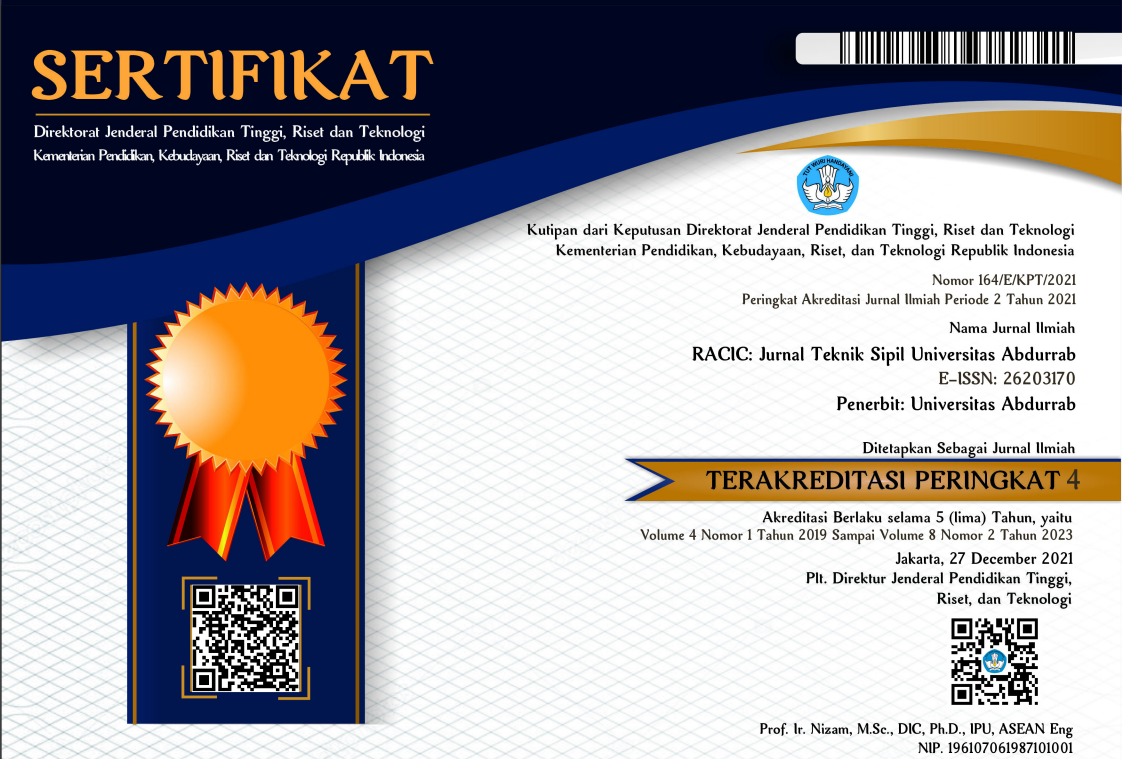STABILISASI TANAH LEMPUNG DENGAN ABU TANDAN SAWIT DAN SEMEN TERHADAP TINGKAT KEPADATAN TANAH
DOI:
https://doi.org/10.36341/racic.v7i1.2421Keywords:
Abu tandan sawit, pemadatan, semen, stabilisasiAbstract
Building construction requires soil conditions that have good bearing capacity so that they can bear the load on it. Clay soils with high plasticity are soils that contain lots of clay grains. The properties of clay that need to be considered are the properties of compression, permeability, and shear strength. To increase the carrying capacity of the clay by compacting it, so that the maximum density is obtained. Mixing the original soil with palm bunch ash and cement will increase the maximum dry density value of clay soil. The purpose of this study was to determine the compaction of the soil mixed with various percentages of palm bunch ash and cement, respectively 5%, 7.5%, and 10%. The addition of palm bunch ash and cement can reduce the value of soil moisture content and increase the value of the dry density of the soil so that the soil becomes denser. The largest dry density value in a mixture of 10% palm bunch ash and cement was 1.42 g/cm³, whereas the dry density value of the original soil was 1.32 g/cm³. The conclusion is that there is an increase in the dry density value of the soil and a decrease in the value of the soil moisture content with the addition of palm bunch ash and cement.
Downloads
References
[2] H. C. Hardiyatmo, Mekanika Tanah 1, Edisi-5. Yogyakarta: Gadjah Mada Unibersity Press, 2010.
[3] S. A. Nugroho, F. Fatnanta, and K. Zaro, “Pengaruh Kadar Air Diatas Optimum Moisture Content Terhadap Nilai CBR Tanah Lempung Organik,†in Prosiding Konferensi Nasional Teknik Sipil 9 (KonTekS 9), 2015, vol. 9, no. KoNTekS 9, pp. 7–8.
[4] A. Refi and Elvanisa, “Pengaruh Variasi Abu Cangkang Sawit terhadap Kembang Susut Tanah Lempung,†Tek. Sipil ITP, vol. 3, no. 2, pp. 1–10, 2016.
[5] Y. M. Azmy, B. Surendro, and M. Amin, “Studi Kepadatan Tanah Untuk Tanah Lempung Berpasir,†J. Rekayasa Infrastruktur Sipil, vol. 3, no. 1, 2018.
[6] H. Kusumah, “Pengaruh Pemadatan Tanah dengan Variasi Campuran Pasir pada Uji Kompaksi,†J. Ilm. Sains dan Teknol., vol. 9, no. 2, pp. 961–968, 2019.
[7] Y. Saraswati, A. Ridwan, and A. Iwan Candra, “Analisis Penerapan Keselamatan Dan Kesehatan Kerja (K3) Pembangunan Gedung Kuliah Bersama Kampus C Unair Surabaya,†J. Manaj. Teknol. Tek. Sipil, vol. 3, no. 2, p. 247, 2020.
[8] Z. Amin, Rismalinda, and A. Ariyanto, “Pengaruh Pencampuran Abu Cangkang Kelapa Sawit Terhadap Nilai Kuat Geser Tanah Lempung,†J. Taxiw., vol. 1, no. 1, pp. 1–8, 2019.
[9] M. Ramadhan, S. Tri Utomo, and L. Suparma, “Stabilisasi Tanah Lempung Menggunakan Semen Dan Aspal Emulsi Terhadap Subgrade Perkerasan Jalan,†Teknisia, vol. XXV, no. 1, pp. 1–10, 2020, doi: 10.20885/teknisia.vol25.iss1.art1.
[10] A. Arrofiq, H, L. Afriani, and Iswan, “Pengaruh Variasi Waktu Pemeraman Terhadap Nilai Uji Kuat Tekan Bebas pada Tanah Lempung dan Lanau yang Distabilisasi Menggunakan Kapur pada Kondisi Optimum,†JRSDD, vol. 4, no. 2, pp. 236–255, 2016.
[11] R. Yuliana, M. Muhardi, and F. Fatnanta, “Karateristik Fisis dan Mekanis Abu Sawit (Palm Oil Fuel Ash) dalam Geoteknik,†Tek. Sipil, Univ. Riau, 2009.
[12] F. Susilowati, Z. F. Haza, D. Sulistyorini, and L. Belakang, “Studi Eksperimental Pengujian Pemadatan Tanah Di Gunungkidul Dengan Metode Standard Proctor,†J. Univ. Sarjanawiyata Tamansiswa, pp. 25–32, 2018.
[13] B. Setiawan, Khalidin, and N. Fadly, “Korelasi antara OMC dengan Batas Plastis pada Proses Pemadatan untuk Tanah Timbun di Aceh,†2012.
[14] P. A. Antara, I. N. Aribudiman, and I. G. N. Wardana, “Pengaruh Penambahan Pasir dan Proses Pemeraman Terhadap Stabilisasi Tanah Ekspansif,†Ilm. Tek. Sipil, vol. 17, no. 2, pp. 145–157, 2013.
[15] S. R. N. Panjaitan, R. Tambunan, and D. Nasution, “Pengaruh Pemadatan Terhadap Nilai CBR Tanah Lempung Yang Distabilisasi Dengan Kapur,†Al Ulum Seri Sainstek, vol. II, pp. 31–39, 2014.
[16] M. Anggraini and A. Saleh, “Stabilisasi Tanah Lempung Dengan Abu Tandan Kosong Kelapa Sawit dan Semen Terhadap Kuat Tekan Bebas,†Sainstek (e-Journal), vol. 9, no. 2, pp. 108–115, 2021, doi: 10.35583/js.v9i2.182.
[17] W. N. Purwati, R. Rokhman, and H. Pristianto, “Pengaruh Kadar Semen Terhadap Stabilitas Tanah Lempung Ditinjau Dari Kuat Geser Tanah,†J. Tek. Sipil Ranc. Bangun, vol. 5, no. 1, p. 42, 2019, doi: 10.33506/rb.v5i1.745.
[18] F. Mandasari and S. Wulandari, “Pengaruh Campuran Garam Dengan Uji Pemadatan Pada Tanah Lempung Ekspansif,†J. Desain Konstr., vol. 16, no. 2, pp. 112–119, 2017, [Online]. Available: https://www.ejournal.gunadarma.ac.id/index.php/dekons/article/view/1800.
Downloads
Published
Issue
Section
License
1. Copyright of all journal manuscripts is held by the RACIC : Rab Construction Research
2. Formal legal provisions to access digital articles of electronic journal are subject to the provision of the Creative Commons Attribution-ShareAlike license (CC BY-NC-SA), which means that RACIC : Rab Construction Research is rightful to keep, transfer media/format, manage in the form of databases, maintain, and publish articles.
3. Published manuscripts both printed and electronic are open access for educational, research, and library purposes. Additionally, the editorial board is not responsible for any violations of copyright law.
licensed under a Creative Commons Attribution-ShareAlike 4.0 International License.





